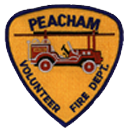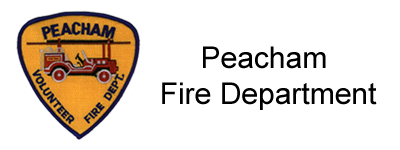Salute to Peacham Volunteer Fire Department
Reprinted and Edited with Permission from The Peacham Patriot, November 1997, Volume 12, Number 1
on the Occasion of the Danville Fair 2000
FIRE! FIRE!
by Lorna Quimby, Peacham Historical Association President
“Wilsons’ are burning!” Maw hurried us to the edge of the lawn, where Deedee and I stood and watched flames leap toward the sky, windows black outlines against the red. I heard a crackling noise. Afterwards, before I went to sleep, I worried over my small possessions. Which would I save first in case we had a fire?
Dad had raced off, milk pail in hand, to help. He and other neighbors passed buckets of water in a human chain from the small brook at the bottom of Wilson’s hill to the fire. How futile a bucket brigade was! Some men worked frantically to rescue what they could before the heat drove them out of the house. In the hurry one threw the box that held Mrs. Wilson’s good dishes out a window. Later, Deedee and I would find shards of china on one side of the ruins.
Everything burned – house, milk house, and barn. The cows were saved – but little else. Willie and Kate lost the home they’d lived in for so long, where most of their children were born, where their daughter Katherine died. They could not rebuild. They moved to South Peacham, to the house back of Bert’s store, where the Dinsmores live now. McPhees rented their fields.
$1,000 went off the Peacham’s 1934 grand list. Our neighborhood in South Peacham shrank. No longer could we see lights in the evening from a house near by, no little dog came out to bark at me when I walked past on my way home from school. Only the concrete watertub, where we filled a pail with water for the school, remained.
Monday, May 14, 1934, the St. Johnsbury Republican reported, “The Moore buildings at Peacham were razed by fire. Edward Moore’s fire burned his home, contents and several other buildings on his farm.” July 16, we note “Ed Moore has bought the Lyford place in South Peacham and is living there.”
The Lyndonville Journal, October 18, 1899, under “Abandoned Farms in Peacham”, listed six farms that “burned and were never rebuilt.” They include the farm of “Deacon Ziba Johnson…on Penny Street at the foot of Cow Hill. Here is where one of Peacham’s brightest men first saw the light, Oliver Johnson, the great anti-slavery worker.”
According to the 1934 town report the town paid ” I. D. Farrow, use of fire truck, $7.00; John A. Roy, use of fire truck, $9.50.” Peacham had no equipment. We paid whichever neighboring town brought its truck to a fire. In 1938, the town of Danville received $50.00 and West Barnet, J. A. Roy, $10. In 1939 P. M. Jennison, fire warden, received mileage of $9.13; J. H. Craig, $2.50; West Barnet, J. A. Roy – fire truck at Blodgett’s, $10.00. Blodgett’s barn burned. Blodgett then sold to Hamilton and Hannah Slaight (Susan O’Brien’s stepfather and mother) and ceased farming.
In 1940, John Roy, Treasurer, West Barnet village, received $20.73 for help at the A. Hastie fire; Barnet Fire District 2, $38.25. The house burned, the Hastie barn remains, slowly deteriorating, beside the Hollow Woods road from East Peacham to the Five Corners. March 18th of the same year, the St. Johnsbury Republican printed, “The barn on the Crepeau place was burned on Wednesday morning.” August 19th a headline in the same newspaper read “Barn on Chandler Farm at Peacham Razed by Fire.” John Chandler was badly burned as he fought to save his horses. For the first time in years, we find a building replaced. An old fashioned barn raising provided the structure that still stands.
In 1945, the Groton Fire department responded to a fire at Paye’s Mill. Payes had a saw mill, gasoline-powered, in South Peacham, on the section of land between the main road to Barnet and the brook. It is hard to realize there once was room for a mill, stacks of lumber – and Alvin and Flora Mackay’s vegetable garden, which was scorched by the heat from the fire. That same year West Barnet department went to a fire at the Dana place.
During 1946 the town paid the Barnet and West Barnet Fire Districts for help at the “Hurley” (Harley) Davis fire. [Dick (Quimby) remembers the Stevens Valley Men’s Club helped Davis take down and move a barn from the old Bradley farm. If anyone can verify this, we would appreciate your response.] (Hartongs now own the building.) In 1947 $408.24 was spent for fire equipment. The state of Vermont reimbursed the town. Inventory, page 6, shows an Indianhead Water Pump; Marine Portable Power Pump, 700 feet rubber hose.
In 1950, we find “Fire Truck & Equipment, $3,411.05.” This is the Willys Jeep still in use which the children enjoy at the Danville Fair.
In 1951, we have the first separate heading for the fire department. They bought some nozzles. Also for the first time, we see “Insurance on Firemen, $93.40.” They paid Danville $25.00 for the Dubray fire (Dubray lived in the Kempton’s house at the edge of the Village. The barn was a total loss.) Total expenses, $121.86.
1952 lists our first chief of the Fire Department, Gilbert Randall, and the first report as a separate heading. The Clifton Schoolcraft Sr.’s house in the Corner was completely destroyed. (V. Anne Brown lives in the house which the Schoolcrafts built as replacement.) The Hardy fire occurred that year, too. Total budget, $1,004.26, of which $592.27 was for fire extinguishers.
Robert Bean became the second fire chief in 1953. During 1957, the Fire Warden responded to the Johnson Hill fire (Ann Mills’ house is on Johnson Hill).
In 1959 the Department bought a Fire Warning System: a Siren frame and installation and fire telephones, which cost $595.63. The “fire telephones” were installed in Department members’ houses. (Nothing brought you out of a sound sleep sooner. Visitors asked, “Why do you have two phones?”) That year the Academy dormitory and the Library burned. The fire truck “is now kept in the town garage (the garage beside the former town office).”
Robert Bean resigned in 1961. Howard Churchill became chief. Perley Jennison’s shingle mill burned. During 1963 Robert Bean’s house and Joseph Vyskup’s barn burned. “The Jeep fire engine was manufactured in 1947; the original tires are still in use. We believe they are unsafe…” (Annual Report for 1963)
1964, Churchill resigned. Robert Fuehrer was appointed. The members attended a Firemanship School at the Monroe Fire House and “Four new tires were purchased.”
1965, Arthur Racque’s home in Green Bay was totally destroyed. (The MacLean’s house and barn are built on that site.) Almost everyone in town was at a meeting in the church that night. And the church had no telephones at the time. People on their way home saw the flames and spread the alarm, but it was too late. The firemen had suits, boots and hats for the first time.
Robert Fuehrer resigned in 1966. George Meech took his place for the rest of the year. On page 14, the department looked for “any women that would be interested in learning to drive the truck. ..there are only two men in town …during the day.”
Clifton Wright became Fire Chief in 1967 and served until 1972. The home of Mr. and Mrs. Charles Kimball was destroyed. The next year,1968, the Powdens’ house burned.
Two fire trucks are listed on the 1969 Inventory. Total expenses for the fire department, $1,164.87. The Hookers had a fire at their home in Peacham Village in 1970. The Department controlled the fire before the building was gutted. They were not able to save the Randall’s barn nor John Sheehan’s trailer the following year. However, they did preserve most of the main house. In 1972 Wayne Guibord’s camp at Martin’s pond burned. In this fire occurred Peacham’s first – and so far only – fire-related fatality as the occupant was overcome by smoke.
1973 through 1977, Donald Randall was Fire Chief. Revenue Sharing began in 1973. The town voted $2,000 to convert the old town garage to a fire station and $1,000 for a tank. From its inception through 1987, when Revenue Sharing ceased, the fire department received $36,257.40. They used the funds for capital projects, to improve equipment and buildings, to meet OSHA standards. During 1974 David Randall’s house (the former South Peacham school) burned, as did Joseph Vyskup’s dwelling in the South Part. The Department bought the tank truck, renovated and moved into the Fire Station and joined Capital Mutual Aid System. The members took a basic 45-hour training course.
New expenses appeared in 1976: heat and electricity for the Station. The Department’s report covers the Academy fire. August 28, at Peacham Academy.
(They) answered the first alarm at 1 o’clock A.M. Smoke and fire in the third floor of the building appeared to be in the area of the bell tower. (They) decided to make a Mutual Aid call to member departments in the surrounding area. 12 depts. responded with 18 pieces of equipment and roughly 125 men. The fire was brought under control by 11:00 A.M.
The Department bought a 1973 Ford for their tank.
1977, Stephen White took Randall’s place. Priester’s barn, two sheds and fifteen acres of land and woods burned. The department had twenty-five members. The “new” fire truck cost $36,188.49.
All these years the fire chief had been paid $50 per year! Albert Goslant became Fire Chief in 1979. The salary increased to $100/year. His report for 1980 requests the townspeople’s support of 4th of July activities. He served through 1983. From 1980 through 1989, the firemen received pay for the hours they spent at fires. After that they requested the amount go into equipment.
In 1984, the selectmen appointed Frederick Stevenson chief. “Due to a decrease in membership the Department will not continue with the celebration this year.”
Stephen Gagliardi, the fire chief in 1986, resigned and Jeffrey Berwick took his place. He still serves the town as our fire chief. 1987, he reported “Eighteen active members.” 1988, they spent $3,092.79 for pagers; $500.00 for 24-hour coverage.
1989, a capital fund was established. $20,868.37 was voted. In 1991 the department held a fire prevention course at the Elementary school. There were twenty-two members, two of whom were women. During 1990, 1992, and 1993 the members used money voted at town meeting to improve the fire house. The building was rewired, insulated. In 1996 there were twenty members. They held a “Cookbook fund raiser” to purchase carbon monoxide detectors. They bought a dry hydrant for the fire pond.
The accompanying graph shows the growth of expenditures for the fire department. Insurance became a major expense from 1981 on. You can observe the escalation of energy costs after 1974. The establishment of a capital fund evens out the peaks and valleys caused by major purchases. You need to consider the growth in the grand list, as well. The “blip” in 1950 on a static grand list was far more painful to the taxpayers than later ones.
What cannot be measured, however, is the improvement in the quality of our fire department. An ongoing item has been education for the members, better equipment – both fire trucks and technological equipment. (Pagers work more effectively than the former telephone system.) Their prompt and efficient response to the Chandler fire this past summer illustrates that quality. We must not take for granted the hours and dedication these men and women give. The bucket brigade is gone but the neighborly spirit lives on!
PEACHAM’S FIRE CHIEFS
Gilbert Randall 1952-53
Robert Bean 1953-61
Howard Churchill 1961-64
Robert Fuehrer 1964-66
George Meech 1966
Clifton Wright 1967-72
Donald Randall 1973-77
Stephen White 1977-78
Albert Goslant 1979-83
Frederick Stevenson 1984-85
Stephen Gagliardi 1986
Jeffrey Berwick 1986-present

